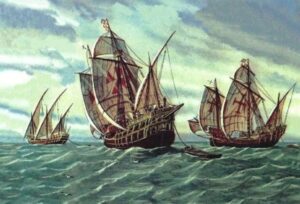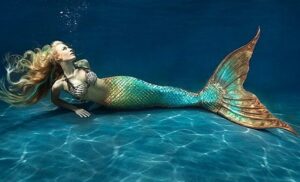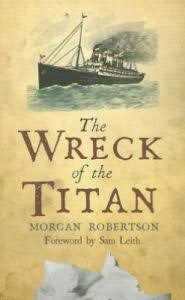fiction

 Hallucinations are not an uncommon phenomenon after long periods of time at sea, but on January 9, 1493, explorer Christopher Columbus, sailing near the Dominican Republic, saw something in the water that was not a hallucination, rather just something he had never seen before. Columbus knew the sea. He was a sailor, but this was not something he had seen before, and he had no knowledge of such a creature to draw from.
Hallucinations are not an uncommon phenomenon after long periods of time at sea, but on January 9, 1493, explorer Christopher Columbus, sailing near the Dominican Republic, saw something in the water that was not a hallucination, rather just something he had never seen before. Columbus knew the sea. He was a sailor, but this was not something he had seen before, and he had no knowledge of such a creature to draw from.
Well, it seems like if we don’t have any idea of what something is, we tend to draw from fiction. That was what Colombus did when he mistakenly thought these creatures in the water were three mermaids. Well, of course, they weren’t mermaids, but manatees. Columbus was so sure of what he saw that he even described them in his journals as “not half as beautiful as they are painted.” Well, if you have seen a manatee, you will agree that they really aren’t what we would call “beautiful.”
Columbus had been at sea for six months, setting sail from Spain, heading across the Atlantic Ocean with the Nina, Pinta and Santa Maria, hoping to find a western trade route to Asia. Of course, we now know that his voyage, the first of four he would make, led him to the Americas, or “New World.” Maybe, it was his long months at sea that caused him to imagine mermaids. Or maybe seeing only water for so long and so far, made the manatees look different to him than they really did, although, he did not imagine them to be beautiful.
Mermaids are, of course, mythical half-female, half-fish creatures, that have graced the imaginations of seafaring cultures since the time of the ancient Greeks. “Typically depicted as having a woman’s head and torso, a fishtail instead of legs and holding a mirror and comb, mermaids live in the ocean and, according to some legends, can take on a human shape and marry mortal men. Mermaids are closely linked to sirens, another folkloric figure, part-woman, part-bird, who live on islands and sing seductive songs to lure sailors to their deaths.”
Those Mermaid sightings by sailors were most likely manatees, dugongs, or Steller’s sea cows…which became extinct by the 1760s due to over-hunting. Manatees are slow-moving aquatic mammals with human-like eyes, bulbous faces and paddle-like tails. There are three different species of manatee…West Indian, West African and Amazonian, and one species of dugong which belong to the Sirenia order. As adults, Manatee are typically 
 10 to 12 feet long and weigh 800 to 1,200 pounds…not exactly the sleek lines most people would associate with the feminine beauty of the mermaid. Manatees are plant-eaters, have a slow metabolism, and can only survive in warm water. Manatees live an average of 50 to 60 years in the wild and have no natural predators. However, they are an endangered species. In the United States, the majority of manatees are found in Florida, where scores of them die or are injured each year due to collisions with boats.
10 to 12 feet long and weigh 800 to 1,200 pounds…not exactly the sleek lines most people would associate with the feminine beauty of the mermaid. Manatees are plant-eaters, have a slow metabolism, and can only survive in warm water. Manatees live an average of 50 to 60 years in the wild and have no natural predators. However, they are an endangered species. In the United States, the majority of manatees are found in Florida, where scores of them die or are injured each year due to collisions with boats.
 Fourteen years before the Titanic sank, Morgan Robertson wrote the novella Futility. It was about the large unsinkable ship “Titan” hitting an iceberg in the Northern Atlantic. Both the Titanic and the fictional Titan did not have enough lifeboats for the thousands of passengers on board. Both were short by about half. While the story behind the sinking of the Titan is somewhat different than the actual events of Titanic, the two are eerily similar, and with so many similarities, one has to wonder how this could have happened. It was like Robertson knew what was coming.
Fourteen years before the Titanic sank, Morgan Robertson wrote the novella Futility. It was about the large unsinkable ship “Titan” hitting an iceberg in the Northern Atlantic. Both the Titanic and the fictional Titan did not have enough lifeboats for the thousands of passengers on board. Both were short by about half. While the story behind the sinking of the Titan is somewhat different than the actual events of Titanic, the two are eerily similar, and with so many similarities, one has to wonder how this could have happened. It was like Robertson knew what was coming.
The story of the Titan puts the “unsinkable” ship sailing through the north Atlantic at breakneck speeds, because as we all know nothing could sink such a ship. Any breech of the holds would immediately close the water-tight doors, stopping the spillover into the other holds. As Titan sailed through the icy waters, they came into an area of fog, and still they did not slow down. Watchmen were posted, one of whom, John Rowland, tended to indulge in drink, since the love of his life left him, and now somehow was on the same ship, and she was married and had a child. While Rowland had been drinking, he was still the one to spot another ship…not that it made a difference. The titan continued full speed ahead, cutting the smaller vessel in half and killing all aboard. The ship still didn’t slow down, and the captain tried to buy the silence of his men, but Rowland would not be bought. As the trip continues, things just get worse. Before long, the ship hits an iceberg, and enough holds are breeched to seal Titan’s doom.
 The book, “The Wreck of the Titan,” originally called “Futility,” was so similar to the events of the Titanic, that it was almost eerie, and yet, it was enough different that you knew it was not the same event. It was simply a “fact is stranger than fiction” situation, and no one could possibly have anticipated that a ship with a very similar name, loaded with people and half the necessary lifeboats, would sail at breakneck speeds across the north Atlantic during a time when the icebergs were floating everywhere, just like the ship in the story, and that the ship…Titanic would suffer the same fate as the storybook ship, Titan suffered, fourteen years after the author dreamed up the story in his mind. And yet that is exactly what happened.
The book, “The Wreck of the Titan,” originally called “Futility,” was so similar to the events of the Titanic, that it was almost eerie, and yet, it was enough different that you knew it was not the same event. It was simply a “fact is stranger than fiction” situation, and no one could possibly have anticipated that a ship with a very similar name, loaded with people and half the necessary lifeboats, would sail at breakneck speeds across the north Atlantic during a time when the icebergs were floating everywhere, just like the ship in the story, and that the ship…Titanic would suffer the same fate as the storybook ship, Titan suffered, fourteen years after the author dreamed up the story in his mind. And yet that is exactly what happened.

